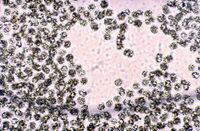Microcystis aeruginosa: Difference between revisions
imported>Yera Patel |
imported>Yera Patel No edit summary |
||
| Line 1: | Line 1: | ||
{{subpages}} | {{subpages}} | ||
{{EZarticle-closed-auto}} | {{EZarticle-closed-auto}} | ||
{{Taxobox | {{Taxobox | ||
| color = pink | | color = pink | ||
| name = | | name = | ||
| image = | | image = cells.jpg | ||
| regnum = | | regnum = Eubacteria | ||
| phylum = | | phylum = Cyanobacteria | ||
| classis = | | classis = Chroobacteria | ||
| ordo = | | ordo = Chroococcales | ||
| familia = | | familia = Microcystaceae | ||
| genus = | | genus = Microcystis | ||
| species = | | species = aeruginosa | ||
| binomial = '' | | binomial = ''Microcystis Aeruginosa'' | ||
| binomial_authority = | | binomial_authority = | ||
}} | }} | ||
Revision as of 10:19, 16 April 2008
Articles that lack this notice, including many Eduzendium ones, welcome your collaboration! |
 | ||||||||||||||
| Scientific classification | ||||||||||||||
| ||||||||||||||
| Binomial name | ||||||||||||||
| Microcystis Aeruginosa |
What is Microcystis?
Microcystis Aeruginosa is a type of harmful blue-green algae which is also referred to as cyanobacteria. They say that the walls of the bacteria are stained gram positive but the cells appear gram negative. This species is colonial, which means that single cells can join together in groups as colonies which tend to float near the water surface. Colony sizes will vary from a few to hundreds of cells. It is a common bloom-forming algae found primarily in nutrient enriched fresh waters and lower salinity waters. Microcystis aeruginosa is one of more than 700 species of algae that may be found in water samples collected and usually blooms in mid to late summer.
Genome structure
Describe the size and content of the genome. How many chromosomes? Circular or linear? Other interesting features? What is known about its sequence? Does it have any plasmids? Are they important to the organism's lifestyle?
Cell structure and metabolism
Describe any interesting features and/or cell structures; how it gains energy; what important molecules it produces.
Ecology
Describe any interactions with other organisms (included eukaryotes), contributions to the environment, effect on environment, etc.
Pathology
How does this organism cause disease? Human, animal, plant hosts? Virulence factors, as well as patient symptoms.
Application to Biotechnology
Does this organism produce any useful compounds or enzymes? What are they and how are they used?
Current Research
Enter summaries of the most recent research here--at least three required